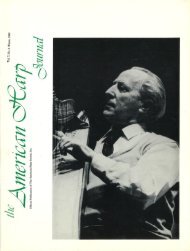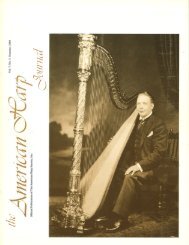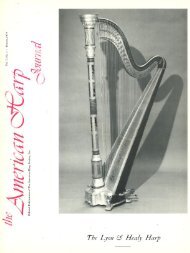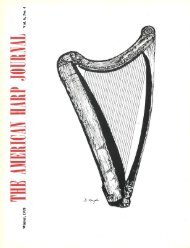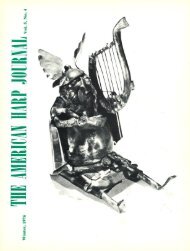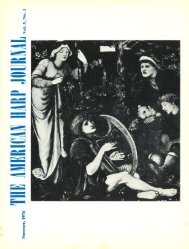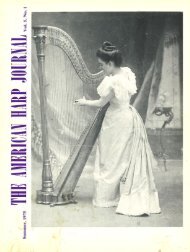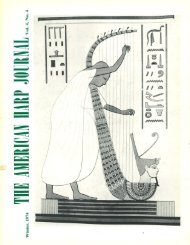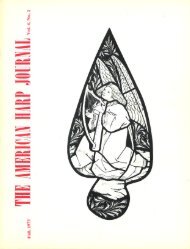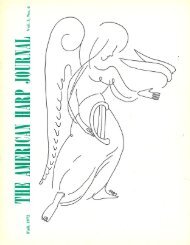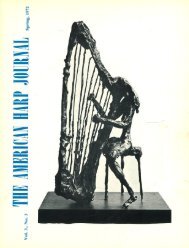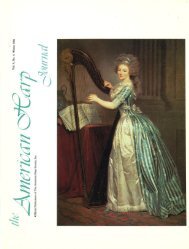AHJ, Vol. 7 No. 1, Summer 1979
AHJ, Vol. 7 No. 1, Summer 1979
AHJ, Vol. 7 No. 1, Summer 1979
Create successful ePaper yourself
Turn your PDF publications into a flip-book with our unique Google optimized e-Paper software.
--·~------<br />
Figure 3 Nancy Calthorpe at her Doorway on Fitzwilliam<br />
Square, Dublin.<br />
Another distinguished performer and teacher of the<br />
Irish Harp is Grainne Yeats (Grainne Ni Eigheartaigh),<br />
who is an authority on Irish folklore and performs<br />
traditional Irish songs, singing to her owll' harp accompaniment.<br />
She is the qau~hter of the well-known<br />
historian, the late P. S. 0 Eigeartaigh. Her husband,<br />
Senator Michael Yeats, is the only son of the late<br />
William Butler Yeats. Grainne Yeats has toured extensively,<br />
both in Europe and America and, recently, in<br />
Japan where there is a flourishing interest in Irish Harp.<br />
Mrs. Yeats is a graduate in History of Trinity College,<br />
Dublin, and received her musical education at the Royal<br />
Academy of Music, as well as privately.<br />
Grainne and Michael Yeats' daughter, Caitriona<br />
Yeats, continues the artistic tradition as a professional<br />
harpist with the pedal harp. Caitriona Yeats was a prize<br />
winner in the Fifth International Harp Contest held in<br />
Jerusalem in September, 1973. She studied the concert<br />
harp in Holland with Edward Witsenburg after early<br />
harp study in Ireland. Caitriona spent some time in<br />
Brookline, Massachusetts, recently, but is now living in<br />
Sweden.<br />
Charles Guard, a fine young harp player from the Isle<br />
of Man, who plays Scots Gaelic music with the group,<br />
The Whistle-binkies, is a student of Grainne Yeats.<br />
Harpmakers<br />
The "Tara Harp" made in Belfast in 1902 by James<br />
MacFall for Cardinal Logue became the prototype for a<br />
style of Irish harp made later by Waltons' of Dublin.<br />
Waltons' presented this harp under the name "Bardic<br />
Harp". The soundbox of the MacFall harp was shaped<br />
like that of the pedal harp, with a rounded back, and the<br />
harp was set upon little feet. The forepillar was bowed,<br />
the head of the harp was high, and the whole thing<br />
Figure 4 Celtic Harp by Walton, Dublin 1978<br />
elaborately decorated with Celtic designwork. A ringtype<br />
device for raising the pitch of the string was<br />
mounted in the neck above each string. Strings were a<br />
combination of gut in the treble and fine wire in the<br />
bass. Waltons' Musical Instrument Galleries, a wellknown<br />
music firm in Dublin, have recently produced a<br />
new design, the "Celtic" Harp, with an improved string<br />
and lever system of adjustable semitone blades. This<br />
may be had with ornate Celtic design pokerwork, or<br />
unadorned. The Walton harps are made on the premises<br />
at their large store on <strong>No</strong>rth Frederick Street by harpmaker<br />
Charles Jordan and his son. They also make<br />
several smaller models. Mr. Patrick A. Walton, a Director<br />
of the firm, takes a personal interest in the harp and<br />
his daughter Aideen is currently studying the harp.<br />
Quinn Harps<br />
Other contemporary Irish harp makers are the Quinn<br />
brothers, who formerly maintained a workshop on the<br />
premises of the Royal Irish Academy of Music, but now<br />
work out of their home. 8 During World War II, when<br />
instruments and supplies were so very scarce, John<br />
Quinn, an expert craftsman, was called upon frequently<br />
by Professor Annie Faban, who taught harp at Sion Hill<br />
Convent and also at the R.I.A.M., to repair the instruments<br />
in her charg~. The head of the Music Department<br />
at Sion Hill, Sister Angela, was intensely devoted<br />
to the revival of the Irish harp, and she used to prevail<br />
upon Quinn to accept harps for repair that were long<br />
past their best and needed considerable skill and effort<br />
to restore. When I visited their workshop in the fall of<br />
1973 Patrick Quinn told me the story of how his brother<br />
became a harpmaker:<br />
"The idea for the Quinn Harp was born on the day<br />
that Sister Angela sent John what he described as a 'bag<br />
of bits' to repair. John remarked that it would be easier<br />
to make a new harp than to repair this collection of<br />
junk! With her usual charm Sister Angela challenged<br />
SUMMER/ <strong>1979</strong><br />
35




